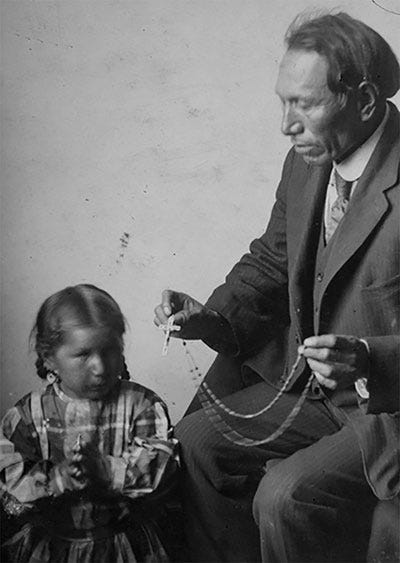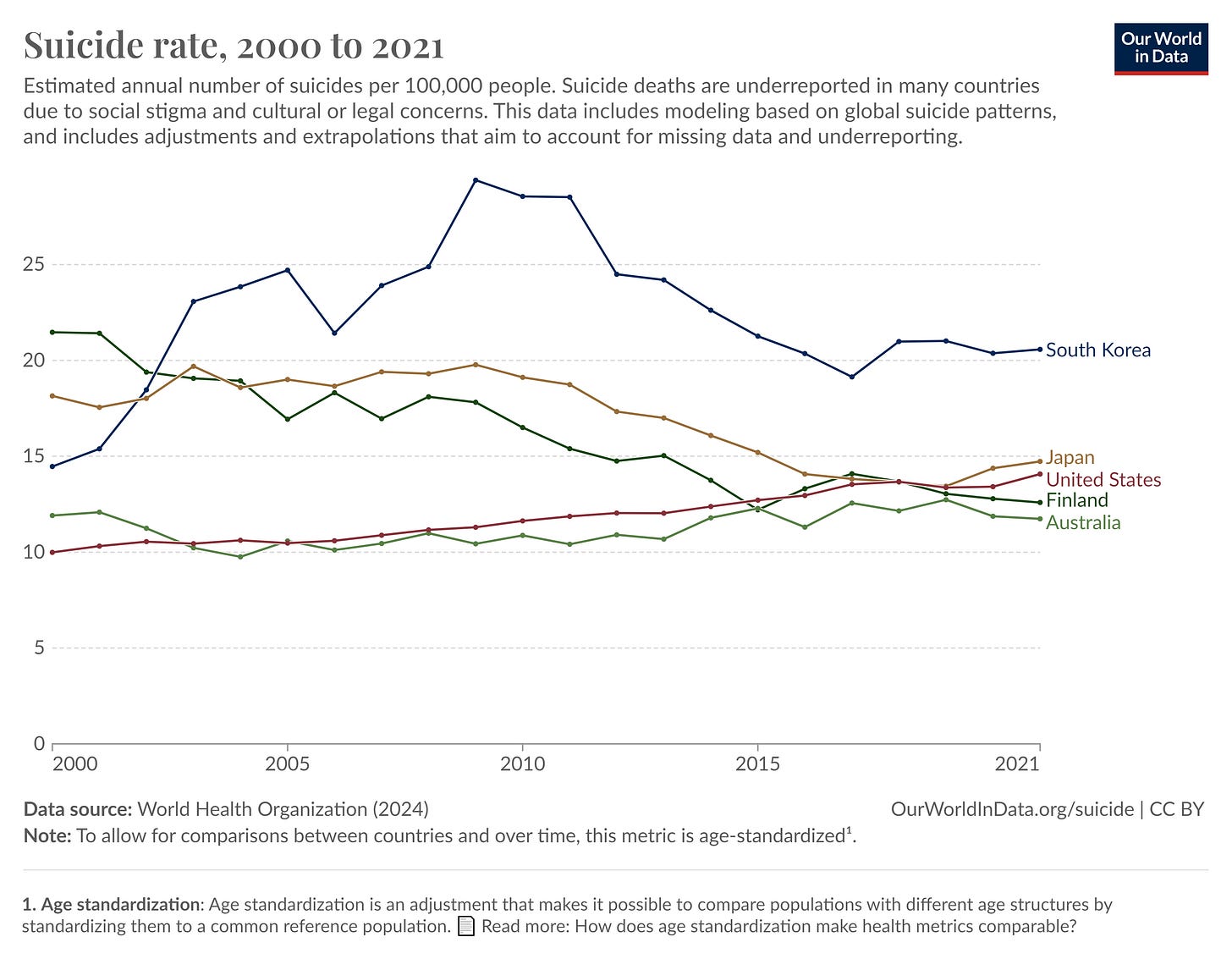World Suicide Prevention Day 2024: Let's Turn Around a Bad Trend
Changing the narrative -- in some places, it is getting better
It’s September 10th again, so it’s World Suicide Prevention Day.
The International Association for Suicide Prevention has this page for resources.
A few years back in the U.S., a new emergency number for suicide help: 988
It has a website: 988 Lifeline
I’m all about fighting death, in all its forms.
I tell people memento mori, but there is no rush to get to that particular finish line.
I have no expertise in suicide prevention. Again, go to the IASP and similar sites. My expertise is in looking at the trends — mainly in the U.S., and also globally.
Prior World Suicide Prevention Days:
September 10, 2023: World Suicide Prevention Day 2023: Let's Turn This Around
September 10, 2022: World Suicide Prevention Day: U.S. Suicide Trend Update through 2021
U.S. high-level trend: 1968-2023
Here is the most recent high-level trend:
Whether measured by crude rate or age-adjusted death rate, suicide rates have increased since the low in 2000.
There was a dip in measured death by suicide in 2020, dropping about 3% in that year, but from 2000 - 2023, the rate increased about 1.4% - 1.5% on an annually compounding rate.
The age-adjusted death rate due to suicide increased by a cumulative 36.5% from 2000 to 2023.
Race/Sex trend, U.S., 1968-2023
The data I have can match up for race going back to 1968 for only a small group, and you can see a wide gap in the death rates here.
I’m not showing the age break-outs, but the age distribution for suicide for men in general is much older than that for women. For white males specifically, suicide rates tend to increase with increasing age.
More detailed snapshot, 2019-2023
In more recent years, more detailed data sets by race/ethnicity exist.
There can be some noise in trends due to smaller groups (I didn’t do all possible breakouts).
That said, for Native Americans, death rates due to suicide and drug overdoses have been much higher than national averages, and became much worse during the pandemic. I mentioned that in last year’s post, as well as in this post:
Other hideous causes of death are very high for Native Americans and Native Alaskans.
To inject a bit of Catholicism for a moment, I like to bring up the canonization cause of Nicholas Black Elk: Dec 2023: “The hidden life of Nicholas Black Elk revealed in canonization process”:
Nicholas Black Elk, an Oglala Lakota Sioux warrior, visionary, and Catholic catechist, is known worldwide but has been misunderstood for decades, according to two Jesuit priests who have emphasized Black Elk’s enduring Catholic faith as his canonization process unfolds.
Nicholas Black Elk lived from 1863 to 1950, converting to Catholicism as an adult. He acted as a catechist to other Native Americans. He has been recognized as a Servant of God, which is a first step to canonization as an officially recognized saint.
Documentary on Nicholas Black Elk at vimeo.
I often ask Nicholas Black Elk for prayers whenever I come across these statistics as I work.
Nicholas Black Elk, pray for us.
Prior posts on U.S. suicide trends
A selection:
Nov 2023: Movember 2023: Men and Suicide
August 30, 2023: Suicide Trends: U.S. Trends by State by Sex 1999-2022
August 14, 2023: Suicide Trends: U.S. Trends by Sex and Race/Ethnicity through 2022
August 17, 2023: Suicide Trends: U.S. Trends for Men by Age Through 2022
August 18, 2023: Suicide Trends: U.S. Trends for Women by Age Through 2022
May 2022: U.S. Gun Deaths are Mostly Suicides, not Homicides
Nov 2022: Movember 2022: The Sex Gap in Suicide
Nov 2021: Movember Fundraising: Men and Suicide
May 2023: U.S. Mortality Trends 2020-2022 part 8: External causes of death [video]
Worldwide suicide trends, selected countries
When one looks worldwide, and over recent trends, you’ll see that many countries have an improving trend on suicide rate (whether age-adjusted or crude rate), and some may be improving but have much higher rates than the U.S.
Data source: Our World in Data: Suicide
There is a question about the quality of the data, though. I’m not sure how much I trust that steadily decreasing line down for Russia. And I never did understand what’s going on in Lesotho. That’s horrid.
Suicide has a lot of shame and stigma surrounding it. It’s not necessarily only personal shame involved to family members after death due to suicide, but public health officials or politicians may not want bad statistics if they can help it. Many countries don’t have the best death records. In the case of the U.S., the book The Poisoner’s Handbook details the corrupt system that could lead to the issuing of fraudulent causes of death under bribery (and in particular, to hide suicide):
I will simplify the graph to show some bad results, for data I do think is credible:
South Korea’s suicide rates have been bad for a long time. They used to be much worse than they are now.
Both Japan’s and Finland’s rates have been decreasing, down to where the U.S. is now, approximately.
Australia has been trucking along relatively level, but has slightly increased. I thought I’d put that in there for comparison. I do wonder if there are some climate effects in improving rates for some areas where it’s getting warmer, or possibly sunnier, but it doesn’t seem like there’s a connection.











